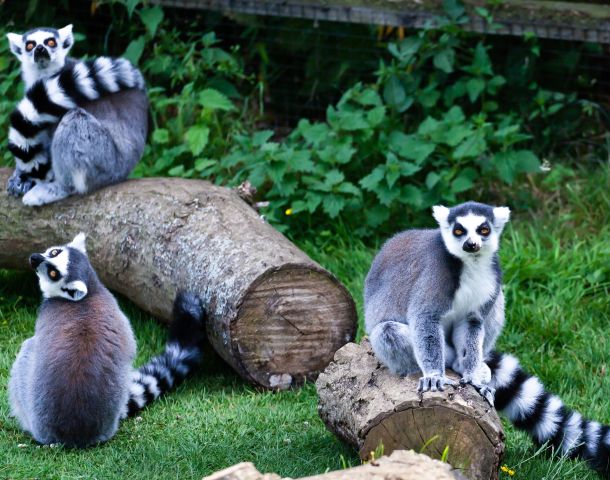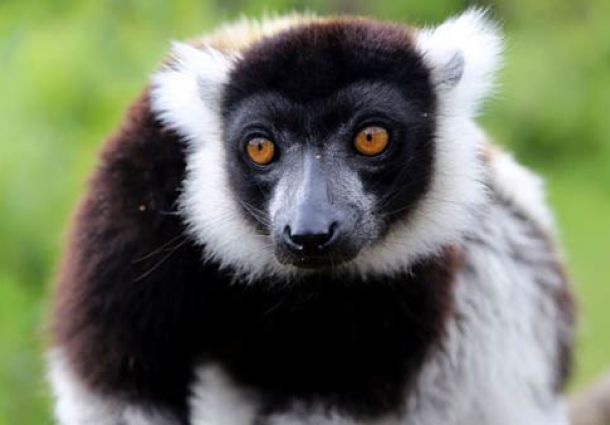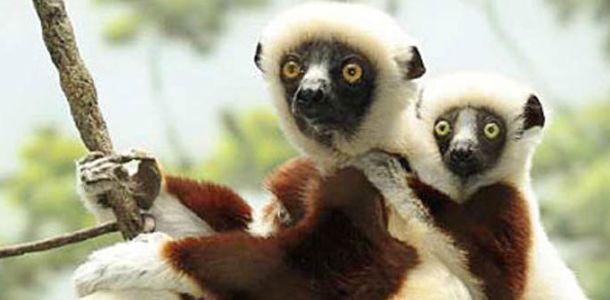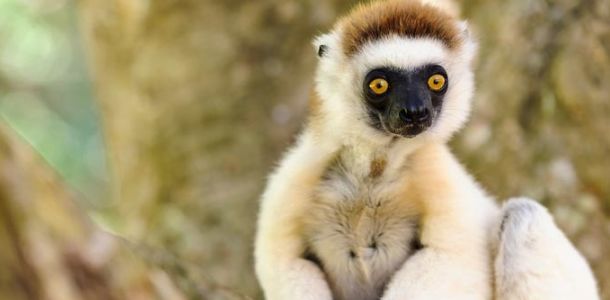There are several species of lemurs. It is believed that there are at least 100 of them that still survive including subspecies. There are also many that are believed to already be extinct over millions of years ago. The smallest primate in the world is a Lemur – the Madame Berthe’s mouse lemur. It weighs just a couple of ounces. According to researchers, 16% of lemur species are considered to be critically endangered, 23% endangered and 25% vulnerable. All of them though have a very uncertain future. For 43 of the species we simply don’t have enough data. Lemurs are only found to live around the areas of Madagascar Islands. They have a very diverse habitat there. Some of them thrive in the forest regions and others do extremely well in the hot desert conditions. They all consume fruits, flowers and insects to help them be able to survive.
Lemur Species

Ring-Tailed Lemur
When you see a photo of the well known Ring-Tailed Lemur there is no mistake what you are looking at. The body of it is very different from other primates. It is considered to be one of the most intelligent of them as well. Local Names are Maki or Hira . Ringtailed lemurs, Lemur catta, inhabit southern and southwestern Madagascar, Andringitra National Park with an additional population on the southeastern plateau of the Andringita Mountains is an average sized lemur, with a head and body length of 385 to 455 mm. The tail is longer than the body, measuring 560 to 624 mm. Individuals weigh between 2.3 and 3.5 kg. The most noticeable characteristic of Lemur catta is its tail, which is black and white. In fact, the species gets its common name from the ringed pattern of the fur on the tail. These lemurs have gray or rosy brown backs with lighter gray or brown hind legs and white stomachs. Their faces are also white with triangular black markings around their eyes and black noses.



Red Ruffed Lemur
The Red Ruffed Lemur is a medium sized species. They don’t associate with any other types of Lemurs. They seem to turn their noses up at them and won’t even nest or feed in the same locations. Local names is Varimena . Varecia rubra (red ruffed lemur) currently lives, along with all extant lemurs, on the island-nation of Madagascar. Red ruffed lemurs inhabit the deciduous tropical forests of the Masoala Peninsula near Maroansetra. The Masoala Peninsula is one of the top conservation efforts in Madagascar. Its rich biodiversity includes more than just red ruffed lemurs: white-fronted brown lemurs, and aye-ayes also live there. Primates represent only a few of the taxonomic reasons why the Masoala National Park was created in the late 1990s. Red ruffed lemurs prefer the deciduous tropical forests of the Masoala Peninsula, although about 400 live elsewhere in captivity. This area is elevated up to 1006 m in areas. Red ruffed lemurs generally remain in the upper canopy of their tropical rainforest. Red ruffed lemurs eat mostly fruit, nectar, and pollen. During the dry season, when food is scarce, these lemurs also occasionally eat some leaves and seeds. When feeding on the nectar of flowers, red ruffed lemurs play a vital role in the pollination of some hardwood trees. Like all lemurs, red ruffed lemurs have insectivorous dentition slightly modified for frugivory. In addition, the toothcomb used for grooming enables easier peeling of fruit.

Indri indri Lemur
The Indri Lemur is also called the Babakoto in many regions. This is one of the largest Lemurs found in the world. They seem to have many behaviors that are humanistic. They have characteristics that are different from many other species of Lemurs. Local Names are Babakoto or Amboanala . Indris, (Indri indri), are found in the northeastern part of Madagascar in rainforests National Park of Mantadia . Indri indri is considered to be the largest of the surviving lemur species. Individuals weigh between 7 and 10 kg when fully mature. The length of the head and body is 60 to 90 cm. The tail is vestigial and is only 5 to 6 cm long. Indris have prominent tufted ears, a long muzzle, long slender legs, short arms, and silky pelage. Individuals have variable pelage coloration, with patterns of grays, browns, blacks, and whites found in this species. The ears are always black, and the face, ears, shoulders, back, and arms are usually black, but may vary in color. Whitish patches may occur on the crown, neck or flanks, but may also occur on the rear and outside surfaces of the arms and legs. Individuals at the northern end of their range tend to be darker, whereas those at the southern end tend to be lighter in color. Indris breed seasonally, with individual females producing one offspring every 2 to 3 years. Births occur in May after a gestation of 120 to 150 days. Young are weaned at about 6 months of age, although they stay close to their mothers for about two years. Females become reproductively mature between 7 and 9 years of age.



Gray Mouse Lemur
It may be hard to believe that the Gray Mouse Lemur is a primate! In fact, many people would likely wager money that it is a rodent by the name and the appearance of it. Yet DNA doesn’t lie and so it is correctly classified as a primate. Local Names are Tsidy, Koitsiky, Titilivaha, Vakiandri, Pondiky . Gray mouse lemurs are extremely arboreal.They move by leaping from the branches of trees. They generally forage close to ground level. They inhabit a wide variety of forest types throughout Madagascar, and are found mostly in the dry deciduous forests of southern and western Madagascar in the regions between Fort-Dulphin and the Sambirano River . The Grey mouse lemur is the largest mouse lemur. Found in dry deciduous lowland forest, in spiny forest and in some degraded forests including plantations between Onilahy River ( south west of Madagascar ) and Ankarafantsika-Ampijoroa forestry station ( north west of Madagascar ). And also an apparently isolated and disjointed population near Mandrare River and in Andohahela National Park ( deep south of Madagascar ).They are one of the smallest living primates and characterized by short limbs and large eyes. The head and body length is 12 to 14 cm and tail length of 13 to 14.5 cm. They have long, thin lower incisors and canines, making a dental comb used for grooming. They have a brownish-grey coat with reddish tones and a pale underside.This species is polygynous; males mate with females in their home ranges.Microcebus murinus reproduce between September and March. The gestation period varys from 54-69 days. They usually give birth to twins. Microcebus murinus are nocturnal foragers. They congregate at a common nest site during the day to sleep. The males sleep in pairs separate from the females. The females sleep in groups of up to fifteen. Females are dominant over males.They are mostly insectivorous. They occasionally eat small reptiles such as chameleons and tree frogs. They also feed on plants, leaves, fruits and flowers.

Golden-Crowned Sifaka
One of the medium sized primates is the Golden-Crowned Sifaka Lemur. They are very limited in number and location. There isn’t much known about them and they were only identified as a unique species in 1974. Local Names are Ankomba malandy, Simpona . Propithecus tattersalli lives in the extreme northeastern regions of Madagascar , in the disappearing dry forest of Daraina in northern of Vohemar . This species inhabits limited forest of Vakona Reserve and Palmarium Reserve. Propithecus tattersali mates seasonally, usually in late January through March. The females in any given group enter estrus only once during the year, and are in estrus for a relatively short time. The gestation period for this species is approximately 130 to 165 days, after which a single infant, weighing about 40 grams, is born. Infants are weaned at 5 to 6 months and reach sexual maturity at 2 to 3 years old. Golden-crowned sifakas live in peaceful groups. Individuals keep in sight of each other and engage in activities such as playing, infant caretaking, and grooming.



Coquerel’s Sifaka
The Coquerel’s Sifaka Lemur is a medium sized one and it belongs to the primate family. It features some very interesting behaviors as well as a look that is different from other Lemurs. Local Names are Ankomba malandy, Tsibahaka . Coquerel’s sifakas (Propithecus coquereli) are endemic to Madagascar. This species resides in dry deciduous forests found to the north and east of the Betsiboka River. It has been reported as far north as Bealanana, as far south as Ambato-Boeni, and to the east in the vicinity of Antetemasy. It can be found in Ankarafantsika National Park as well as the Bora Special Reserve. Coquerel’s sifakas engage in auditory, visual and olfactory communication. Alarm calls used for aerial predators are often described as roaring barks and growls. General alarm calls, which sound like "sifaka" with an explosive clicking sound at the end, are used to alert group members of terrestrial predators. When separated from their group, Coquerel's sifakas emit a loud, extended wail. Facial expressions and body postures include a play face where the mouth is held open in a silent laugh, and head jerks where the head is thrown quickly back while calling when facing a predator . Coquerel’s sifakas are preyed upon by hawks and other raptors, constrictor snakes as well as the puma-like fossa, the largest mammalian carnivore found on Madagascar .Propithecus tattersalli is probaly one of the most endangered lemurs on Madagascar, with numbers dwindling to less than 8,000 individuals .

Red Brown Lemur
The Red Collared Lemur is a primate that is medium in size. They are found naturally in western and eastern Madagascar. Local Names is Varika . There is also a small introduced population in Southern Madagascar at the Berenty Private Reserve . Red-fronted brown lemurs have an average weight of about 2.7 kg and their average body length is 40 cm. The tail is about 55 cm long. The males are gray to gray-brown and have a reddish crown. The females are reddish-brown. All red-fronted brown lemurs have pale patches over their eyes.One individual of this species lived over 36 years in captivity. It is likely that, as with other lemurs in the genus, the maximum lifespan in the wild ranges between 20 and 25 years.Red-fronted lemurs are mainly folivorous (leaf-eating). They also consume pods, stems, flowers, fruit, bark and sap of the kily tree (Tamarindus indica). However, they have very adaptable diets. These lemurs have the ability to shift their normally herbivorous diet to invertebrates and fungi when plant matter is scarce. Eastern populations are specifically known to include insects, bird eggs, and dirt in their diets. They are known to have higher dietary diversity than those populations found in the west and a unique predominance of fruit.


Black Lemur
The Black Lemur is a type of primate and there are two subspecies that have been identified. They are the Slader Lemur and the E. Macaco Lemur. In many locations the ranged of them overlap and that has led to mixed breeding. Local Names are Akomba , Komba . They are found in northwest Madagascar: on the islands of Nosy Be and Nosy Komba, and along the coast from Anivorano Nord to Maromandia. They are tree dwellers and can be found in four habitats: primary rain forest, secondary forest, timber plantations and food crop plantations. There is striking sexual dimorphism in color. Males in both subspecies are black. Female black lemurs have a dark coat which lightens to a deep rust on the sides. Females are dominant to males, and there may be some exchange of adults between groups. In captivity, females have their choice of mates. Black lemurs breed seasonally in June and July. Birth occurs after a gestation period of 120 to 129 days. One offspring is usually born, however, twins are fairly common. The young are weaned at five to six months of age. Sexual maturity is reached by about 2 years of age.



Aye-Aye
The Aye-aye is one of the world's most bizarre creatures with its long twig-like middle finger, huge eyes, rat-like teeth, and large bat-like ears. This nocturnal lemur, first classified as a rodent, uses its long middle finger as a tool for finding insects. After tapping the tree bark, it uses its sensitive hearing to detect the movement of insect larvae. Studies have found that the aye-aye is capable of sensing insect movement at a depth of 12 feet. Sadly this odd creature is endangered by both habitat destruction in northeastern Madagascar and widespread persecution by native Malagasy as an harbinger of bad luck. Local Names is Aye Aye . The aye-aye has been found to be widely distributed in a variety of native forest types. It has been recorded at localities covering the entire extent of the eastern rainforest belt and in the moist forests of the Sambirano region in the northwest, the drier forests to the south in the vicinity of the Manasamody hills, the deciduous forests of Ankarana National Park , the rainforests of Amber Mountain National¨Park in the far north and in The Palmarium Reserve, and some cultivated areas like coconut and lychee nut plantations . This family contains a single species, the highly distinctive aye-aye. These animals are around 400 mm long excluding the bushy tail, which more than doubles the body length. The fur is long, woolly, and dark brown in color. The combination of bushy tail and woolly fur gives the animal a sort of unkempt, shaggy appearance. Aye-ayes have large, naked, mobile ears, a muzzle that is shorter than that of most lemurs but longer than lorises, and large eyes with yellowish brown irises. Aye-ayes eat insect larvae, which they retrieve from bark and wood by gnawing holes with their rodent-like incisors, then hooking the larvae out with their enlarged third forefingers. They locate wood-boring larvae by tapping on branches with the third finger and listening for movement. They also feed on fruit, eggs, and bamboo shoots .

Verreaux’s Sifaka
The Verreaux’s Sifaka Lemur is medium in size when compared to other species. It is a primate and looks very similar to many small species of monkeys. Local Names is Sifaka . Verreaux's sifakas are found in dry and spiny forests of southern and southwest Madagascar from the Tsiribihina River to Andohahela. Easily seen at Berenty National Park , Andohahela National Park and Palmarium Reserve .They have distinct coloration with white fur and a hint of yellow contrasting their hairless, black face. Their hands and feet are also black. They have a long tail that ranges from 43 to 56 cm in length, roughly the same length as their body (45 to 55 cm). Verreaux's sifakas are not sexually dimorphic, as both males and females weigh between 3 and 7 kg.The average lifespan of captive Verreaux's sifakas is 18 years with a recorded maximum of 23.5 years. Verreaux's sifakas are herbivorous and feed primarily on leaves, bark, and flowers. When abundant, fruit may also be incorporated into their diet. Nutrition levels directly coincide with season and rainfall amounts, with food of higher nutritional value being most abundant during the wet season.





